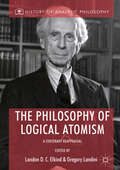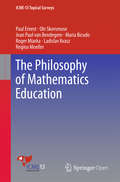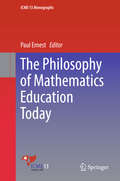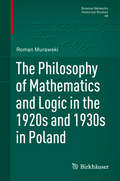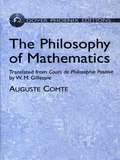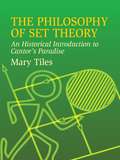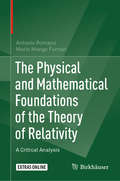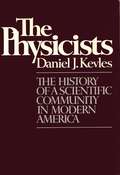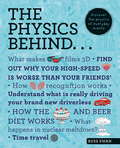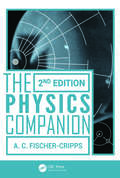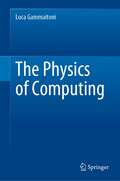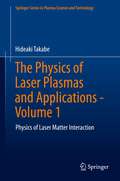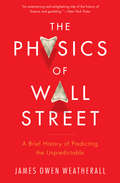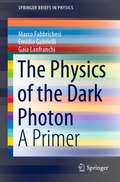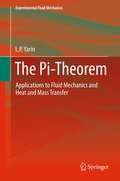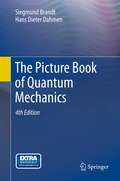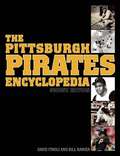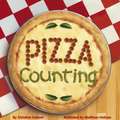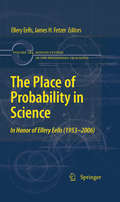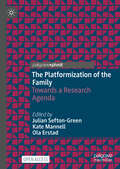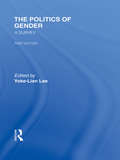- Table View
- List View
The Philosophy of Logical Atomism: A Centenary Reappraisal (History of Analytic Philosophy)
by Gregory Landini Landon D. ElkindThis book offers a comprehensive critical survey of issues of historical interpretation and evaluation in Bertrand Russell's 1918 logical atomism lectures and logical atomism itself. These lectures record the culmination of Russell's thought in response to discussions with Wittgenstein on the nature of judgement and philosophy of logic and with Moore and other philosophical realists about epistemology and ontological atomism, and to Whitehead and Russell’s novel extension of revolutionary nineteenth-century work in mathematics and logic. Russell's logical atomism lectures have had a lasting impact on analytic philosophy and on Russell's contemporaries including Carnap, Ramsey, Stebbing, and Wittgenstein. Comprised of 14 original essays, this book will demonstrate how the direct and indirect influence of these lectures thus runs deep and wide.
The Philosophy of Mathematics Education
by Paul Ernest Ole Skovsmose Jean Paul van Bendegem Maria Bicudo Roger Miarka Ladislav Kvasz Regina MoellerAlthough many agree that all teaching rests on a theory of knowledge, there has been no in-depth exploration of the implications of the philosophy of mathematics for education. This is Paul Ernest's aim. Building on the work of Lakatos and Wittgenstein it challenges the prevalent notion that mathematical knowledge is certain, absolute and neutral, and offers instead an account of mathematics as a social construction. This has profound educational implications for social issues, including gender, race and multiculturalism; for pedagogy, including investigations and problem solving; and challenges hierarchical views of mathematics, learning and ability. Beyond this, the book offers a well-grounded model of five educational ideologies, each with its own epistemology, values, aims and social group of adherents. An analysis of the impact of these groups on the National Curriculum results in a powerful critique, revealing the questionable assumptions, values and interests upon which it rests. The book finishes on an optimistic note, arguing that pedagogy, left unspecified by the National Curriculum, is the way to achieve the radical aims of educating confident problem posers and solvers who are able to critically evaluate the social uses of mathematics.
The Philosophy of Mathematics Education Today (ICME-13 Monographs)
by Paul ErnestThis book offers an up-to-date overview of the research on philosophy of mathematics education, one of the most important and relevant areas of theory. The contributions analyse, question, challenge, and critique the claims of mathematics education practice, policy, theory and research, offering ways forward for new and better solutions. The book poses basic questions, including: What are our aims of teaching and learning mathematics? What is mathematics anyway? How is mathematics related to society in the 21st century? How do students learn mathematics? What have we learnt about mathematics teaching? Applied philosophy can help to answer these and other fundamental questions, and only through an in-depth analysis can the practice of the teaching and learning of mathematics be improved. The book addresses important themes, such as critical mathematics education, the traditional role of mathematics in schools during the current unprecedented political, social, and environmental crises, and the way in which the teaching and learning of mathematics can better serve social justice and make the world a better place for the future.
The Philosophy of Mathematics and Logic in the 1920s and 1930s in Poland
by Roman MurawskiThe aim of this book is to present and analyze philosophical conceptions concerning mathematics and logic as formulated by Polish logicians, mathematicians and philosophers in the 1920s and 1930s. It was a remarkable period in the history of Polish science, in particular in the history of Polish logic and mathematics. Therefore, it is justified to ask whether and to what extent the development of logic and mathematics was accompanied by a philosophical reflection. We try to answer those questions by analyzing both works of Polish logicians and mathematicians who have a philosophical temperament as well as their research practice. Works and philosophical views of the following Polish scientists will be analyzed: WacÅ,aw SierpiÅ,,ski, Zygmunt Janiszewski, Stefan Mazurkiewicz, Stefan Banach Hugo Steinhaus, Eustachy Å»yliÅ,,sk and Leon Chwistek, Jan Å ukasiewicz, Zygmunt Zawirski, StanisÅ,aw LeÅ>niewski, Tadeusz KotarbiÅ,,ski, Kazimierz Ajdukiewicz, Alfred Tarski, Andrzej Mostowski and Henryk Mehlberg, Jan SleszyÅ,,ski, StanisÅ,aw Zaremba and Witold Wilkosz. To indicate the background of scientists being active in the 1920s and 1930s we consider in Chapter 1 some predecessors, in particular: Jan Åsniadecki, Józef Maria Hoene-WroÅ,,ski, Samuel Dickstein and Edward Stamm.
The Philosophy of Mathematics: Translated from Cours de Philosophie Positive by W. M. Gillespie
by Auguste ComteWritten by the nineteenth-century French philosophical founder of positivism, this comprehensive map of mathematical science assigns to each part of the complex whole its true position and value. The two-part treatment begins with a general view of mathematical analysis and advances to algebra, continuing with an exploration of geometry's ancient and modern methods.
The Philosophy of Penelope Maddy (Outstanding Contributions to Logic #31)
by Juliette Kennedy Sophia ArbeiterThis volume features more than 20 essays that explore the work of one of the most important contemporary philosophers of mathematics. It will help readers to better appreciate this significant and prolific philosopher. Within philosophy of mathematics, Penelope Maddy initially advocated realism. She then went on to advance naturalism. Both of her positions became very influential in the field, along with her other work in the philosophy of logic. The contributors comment on and otherwise engage with Maddy’s work. They also weigh in on the state of set theory and its philosophy, the philosophy and history of logic, naturalism, skepticism, and the myriad other areas to which Maddy left her mark. Overall, coverage traces her influence on these various ideas over the years. It will also help readers to better understand how philosophers working at the forefront of these areas see these concepts today. These essays will be essential reading for the wide group of philosophers working in these different areas as well as graduate students studying philosophy of mathematics and logic and the other related issues to which Maddy has contributed. The volume will also appeal to logicians and set theorists in general, as well as to philosophers working in analytic philosophy more widely, as well as to those working in the history of philosophy.
The Philosophy of Set Theory: An Historical Introduction to Cantor's Paradise
by Mary TilesA century ago, Georg Cantor demonstrated the possibility of a series of transfinite infinite numbers. His methods, unorthodox for the time, enabled him to derive theorems that established a mathematical reality for a hierarchy of infinities. Cantor's innovation was opposed, and ignored, by the establishment; years later, the value of his work was recognized and appreciated as a landmark in mathematical thought, forming the beginning of set theory and the foundation for most of contemporary mathematics. As Cantor's sometime collaborator, David Hilbert, remarked, "No one will drive us from the paradise that Cantor has created." This volume offers a guided tour of modern mathematics' Garden of Eden, beginning with perspectives on the finite universe and classes and Aristotelian logic. Author Mary Tiles further examines permutations, combinations, and infinite cardinalities; numbering the continuum; Cantor's transfinite paradise; axiomatic set theory; logical objects and logical types; and independence results and the universe of sets. She concludes with views of the constructs and reality of mathematical structure. Philosophers with only a basic grounding in mathematics, as well as mathematicians who have taken only an introductory course in philosophy, will find an abundance of intriguing topics in this text, which is appropriate for undergraduate-and graduate-level courses.
The Physical and Mathematical Foundations of the Theory of Relativity: A Critical Analysis
by Antonio Romano Mario Mango FurnariThis unique textbook offers a mathematically rigorous presentation of the theory of relativity, emphasizing the need for a critical analysis of the foundations of general relativity in order to best study the theory and its implications. The transitions from classical mechanics to special relativity and then to general relativity are explored in detail as well, helping readers to gain a more profound and nuanced understanding of the theory as a whole. After reviewing the fundamentals of differential geometry and classical mechanics, the text introduces special relativity, first using the physical approach proposed by Einstein and then via Minkowski’s mathematical model. The authors then address the relativistic thermodynamics of continua and electromagnetic fields in matter – topics which are normally covered only very briefly in other treatments – in the next two chapters. The text then turns to a discussion of general relativity by means of the authors’ unique critical approach, underlining the difficulty of recognizing the physical meaning of some statements, such as the physical meaning of coordinates and the derivation of physical quantities from those of space-time. Chapters in this section cover the model of space-time proposed by Schwarzschild; black holes; the Friedman equations and the different cosmological models they describe; and the Fermi-Walker derivative. Well-suited for graduate students in physics and mathematics who have a strong foundation in real analysis, classical mechanics, and general physics, this textbook is appropriate for a variety of graduate-level courses that cover topics in relativity. Additionally, it will interest physicists and other researchers who wish to further study the subtleties of these theories and understand the contemporary scholarly discussions surrounding them.
The Physicists: The History of a Scientific Community in Modern America
by Daniel J. KevlesThis magnificent account of the coming of age of physics in America has been heralded as the best introduction to the history of science in the United States. Unsurpassed in its breadth and literary style, Kevles's account portrays the brilliant scientists who became a powerful force in bringing the world into a revolutionary new era. The book ranges widely as it links these exciting developments to the social, cultural, and political changes that occurred from the post-Civil War years to the present. Throughout, Kevles keeps his eye on the central question of how an avowedly elitist enterprise grew and prospered in a democratic culture. In this new edition, the author has brought the story up to date by providing an extensive, authoritative, and colorful account of the Superconducting Super Collider, from its origins in the international competition and intellectual needs of high-energy particle physics, through its establishment as a multibillion-dollar project, to its termination, in 1993, as a result of angry opposition within the American physics community and the Congress.
The Physics Behind... (The Behind... series)
by Russ SwanCan you really lose weight by consuming nothing but ice cream and beer? How does the latest blockbuster movie get squeezed onto a disk, and how do they make the pictures seem 3D? How much does a selfie weigh? What's the science behind forensic investigations, body scans, and the dating of ancient artefacts?The Physics Behind... takes the reader on a fascinating journey through the scientific principles that that make the modern world work. Could there be life on Mars? Why is north really south? How do self-driving cars find their way around? These and many more topics are explored by starting with the basic science that makes them tick - examining the physics behind them. Packed with detailed original artwork and infographics, The Physics Behind... is perfect for anyone who has ever been curious about the science of life.Including:- The physics behind modern life: Wi-Fi, Facial recognition, touchscreens, microwave ovens, the ice cream and beer diet, taking a selfie, Flash memory, a bag of sugar, catching the train, calendars and clocks- The physics behind entertainment: optical discs, lasers, white water, executive toys, the electric guitar, music, 3D movies- The physics behind analysis: medical imaging, looking at little things, spectroscopy, crime scene investigation, tricorder, microfluidics, radiocarbon dating, proving the Earth is round- The physics behind space: rocket science, space weather, Planet Nine, space telescopes, is there anybody out there? life on Earth, life on Mars- The physics behind big science: what's the matter?, time travel, bomb or meltdown?, the Large Hadron Collider, the Human Genome Project, the Standard Model, gravity, everything- The physics behind the weird universe: strings, rings and other things, N-dimensional space, the hypercube, antimatter, the dark universe, quantum weirdness, quantum biology, time crystals and Majorana- The physics behind the environment: weather forecasts, climate change, renewable energy, migration, peacock feathers, sunburn, rainbows, spider silk- The physics behind transportation: autonomous autos, Hyperloop, Maglev, satellite navigation, motor sport, going rreeaallllyy fast, stealth- The physics behind everything else: curve balls, the Mpemba Effect, why north is really south, perpetual motion and the heat death of the universe, and the physics behind this book.
The Physics Behind...: Discover The Physics Of Everyday Life
by Russ SwanCan you really lose weight by consuming nothing but ice cream and beer? How does the latest blockbuster movie get squeezed onto a disk, and how do they make the pictures seem 3D? How much does a selfie weigh? What's the science behind forensic investigations, body scans, and the dating of ancient artefacts?The Physics Behind... takes the reader on a fascinating journey through the scientific principles that that make the modern world work. Could there be life on Mars? Why is north really south? How do self-driving cars find their way around? These and many more topics are explored by starting with the basic science that makes them tick - examining the physics behind them. Packed with detailed original artwork and infographics, The Physics Behind... is perfect for anyone who has ever been curious about the science of life.Including:- The physics behind modern life: Wi-Fi, Facial recognition, touchscreens, microwave ovens, the ice cream and beer diet, taking a selfie, Flash memory, a bag of sugar, catching the train, calendars and clocks- The physics behind entertainment: optical discs, lasers, white water, executive toys, the electric guitar, music, 3D movies- The physics behind analysis: medical imaging, looking at little things, spectroscopy, crime scene investigation, tricorder, microfluidics, radiocarbon dating, proving the Earth is round- The physics behind space: rocket science, space weather, Planet Nine, space telescopes, is there anybody out there? life on Earth, life on Mars- The physics behind big science: what's the matter?, time travel, bomb or meltdown?, the Large Hadron Collider, the Human Genome Project, the Standard Model, gravity, everything- The physics behind the weird universe: strings, rings and other things, N-dimensional space, the hypercube, antimatter, the dark universe, quantum weirdness, quantum biology, time crystals and Majorana- The physics behind the environment: weather forecasts, climate change, renewable energy, migration, peacock feathers, sunburn, rainbows, spider silk- The physics behind transportation: autonomous autos, Hyperloop, Maglev, satellite navigation, motor sport, going rreeaallllyy fast, stealth- The physics behind everything else: curve balls, the Mpemba Effect, why north is really south, perpetual motion and the heat death of the universe, and the physics behind this book.
The Physics Companion
by Anthony C. Fischer-CrippsGet Up to Speed on PhysicsUpdated and expanded with new topics, The Physics Companion, 2nd Edition offers a unique and educational approach to learning physics at a level suitable for first-year science students. This new edition expands the presentation to include senior topics, such as statistical mechanics, quantum physics, and nuclear physics.
The Physics of Computing
by Luca GammaitoniThis book presents a self-contained introduction to the physics of computing, by addressing the fundamental underlying principles that involve the act of computing, regardless of the actual machine that is used to compute. Questions like “what is the minimum energy required to perform a computation?”, “what is the ultimate computational speed that a computer can achieve?” or “how long can a memory last”, are addressed here, starting from basic physics principles. The book is intended for physicists, engineers, and computer scientists, and it is designed for self-study by researchers who want to enter the field or as the main text for a one semester course at advanced undergraduate or graduate level. The theoretical concepts presented in this book are systematically developed from the very beginning, which only requires basic knowledge in physics and mathematics.
The Physics of Laser Plasmas and Applications - Volume 1: Physics of Laser Matter Interaction (Springer Series in Plasma Science and Technology)
by Hideaki TakabeThe series of books discusses the physics of laser and matter interaction, fluid dynamics of high-temperature and high-density compressible plasma, and kinetic phenomena and particle dynamics in laser-produced plasma. The book (Vol.1) gives the physics of intense-laser absorption in matter and/or plasma in non-relativistic and relativistic laser-intensity regime. In many cases, it is explained with clear images of physics so that an intuitive understanding of individual physics is possible for non-specialists. For intense-laser of 1013-16 W/cm2, the laser energy is mainly absorbed via collisional process, where the oscillation energy is converted to thermal energy by non-adiabatic Coulomb collision with the ions. Collisionless interactions with the collective modes in plasma are also described. The main topics are the interaction of ultra-intense laser and plasma for the intensity near and over 1018W/cm2. In such regime, relativistic dynamics become essential. A new physics appears due to the relativistic effects, such as mass correction, relativistic nonlinear force, chaos physics of particle motions, and so on. The book provides clearly the theoretical base for challenging the laser-plasma interaction physics in the wide range of power lasers. It is suitable as a textbook for upper-undergraduate and graduate students as well as for readers who want to understand the whole physics structure about what happen when an intense-laser irradiates any materials including solids, gas etc. Explaining the physics intuitively without complicated mathematics, it is also a valuable resource for engineering students and researchers as well as for self-study.
The Physics of Wall Street: A Brief History of Predicting the Unpredictable
by James Owen WeatherallA look inside the world of &“quants&” and how science can (and can&’t) predict financial markets: &“Entertaining and enlightening&” (The New York Times). After the economic meltdown of 2008, Warren Buffett famously warned, &“beware of geeks bearing formulas.&” But while many of the mathematicians and software engineers on Wall Street failed when their abstractions turned ugly in practice, a special breed of physicists has a much deeper history of revolutionizing finance. Taking us from fin-de-siècle Paris to Rat Pack–era Las Vegas, from wartime government labs to Yippie communes on the Pacific coast, James Owen Weatherall shows how physicists successfully brought their science to bear on some of the thorniest problems in economics, from options pricing to bubbles. The crisis was partly a failure of mathematical modeling. But even more, it was a failure of some very sophisticated financial institutions to think like physicists. Models—whether in science or finance—have limitations; they break down under certain conditions. And in 2008, sophisticated models fell into the hands of people who didn&’t understand their purpose, and didn&’t care. It was a catastrophic misuse of science. The solution, however, is not to give up on models; it&’s to make them better. This book reveals the people and ideas on the cusp of a new era in finance, from a geophysicist using a model designed for earthquakes to predict a massive stock market crash to a physicist-run hedge fund earning 2,478.6% over the course of the 1990s. Weatherall shows how an obscure idea from quantum theory might soon be used to create a far more accurate Consumer Price Index. The Physics of Wall Street will change how we think about our economic future. &“Fascinating history . . . Happily, the author has a gift for making complex concepts clear to lay readers.&” —Booklist
The Physics of the Dark Photon: A Primer (SpringerBriefs in Physics)
by Marco Fabbrichesi Emidio Gabrielli Gaia LanfranchiThis book is about the dark photon which is a new gauge boson whose existence has been conjectured. Due to its interaction with the ordinary, visible photon, such a particle can be experimentally detected via specific signatures. In this book, the authors review the physics of the dark photon from the theoretical and experimental point of view. They discuss the difference between the massive and the massless case, highlighting how the two phenomena arise from the same vector portal between the dark and the visible sector. A review of the cosmological and astrophysical observations is provided, together with the connection to dark matter physics. Then, a perspective on current and future experimental limits on the parameters of the massless and massive dark photon is given, as well as the related bounds on milli-charged fermions. The book is intended for graduate students and young researchers who are embarking on dark photon research, and offers them a clear and up-to-date introduction to the subject.
The Pi-Theorem
by L. P. YarinThis volume presents applications of the Pi-Theorem to fluid mechanics and heat and mass transfer. The Pi-theorem yields a physical motivation behind many flow processes and therefore it constitutes a valuable tool for the intelligent planning of experiments in fluids. After a short introduction to the underlying differential equations and their treatments, the author presents many novel approaches how to use the Pi-theorem to understand fluid mechanical issues. The book is a great value to the fluid mechanics community, as it cuts across many subdisciplines of experimental fluid mechanics.
The Picture Book of Quantum Mechanics
by Hans Dieter Dahmen Siegmund BrandtThe aim of this book is to explain the basic concepts and phenomena of quantum mechanics by means of visualization. Computer-generated illustrations in color are used extensively throughout the text, helping to establish the relation between quantum mechanics--wave functions, interference, atomic structure, and so forth--and classical physics--point mechanics, statistical mechanics, and wave optics. Even more important, by studying the pictures in parallel with the text, readers develop an intuition for such notoriously abstract phenomena as the tunnel effect excitation and decay of metastable states wave-packet motion within a well systems of distinguishable and indistinguishable particles free wave packets and scattering in 3 dimensions angular-momentum decomposition stationary bound states in various 3-dimensional potentials hybrid states Kepler motion of wave packets in the Coulomb field spin and magnetic resonance Illustrations from experiments in a variety of fields, including chemistry, and molecular, atomic, nuclear, and particle physics, underline the basic as well as the practical importance of quantum mechanics. In the present, fourth edition all computer graphics are presented in full color. It also contains additional physics topics such as hybridization. Praise for Previous Editions "The book is highly recommended as a complement to any standard textbook in quantum mechanics, but it will also be valuable to all of us who studied quantum mechanics without the pictures." -- International Journal of Quantum Chemistry "This book would be an excellent basis for the study of special topics in a quantum physics course. Most serious students of physics and all of their teachers will want to consider having this orderly and graphic outline of introductory quantum theory at their fingertips." -- American Journal of Physics "Their aim is the presentation of the 'principal ideas of wave mechanics' in such a way that students can build a quantum intuition out of their graphics." -- Scientific American "This is a unique book. It does not provide a complete course in quantum theory, but as a companion work of reference it should be quite useful to students in providing insights into the dynamical structure of the theory." -- Nature
The Pittsburgh Pirates Encyclopedia
by David Finoli Bill RanierThe Pittsburgh Pirates have one of the most storied histories in the annals of baseball. The Pittsburgh Pirates Encyclopedia captures these fabulous times through the stories of the individuals and the collective teams that have thrilled the Steel City for 125 years. The book breaks down the team with a year-by-year synopsis of the club, including biographies of more than 180 of the most memorable Pirates through the ages as well as a look at each manager, owner, general manager, and announcer who has served the club proudly.Now updated through the 2014 season, The Pittsburgh Pirates Encyclopedia will provide Pirates fans as well as baseball fans in general a complete look into the team's history, sparking memories of glories past and hopes for the future. Highlights include: Single-season and career records Player and manager profiles Pirates award winners Synopses of key games in Pirates historyNow fully updated, this is one of the most comprehensive books ever written about the Pirates, and a resource that no Bucs fan should be without.
The Pittsburgh Pirates Encyclopedia
by David Finoli Bill RanierThe Pittsburgh Pirates have one of the most storied histories in the annals of baseball. The Pittsburgh Pirates Encyclopedia captures these fabulous times through the stories of the individuals and the collective teams that have thrilled the Steel City for 125 years. The book breaks down the team with a year-by-year synopsis of the club, including biographies of more than 180 of the most memorable Pirates through the ages as well as a look at each manager, owner, general manager, and announcer who has served the club proudly.Now updated through the 2014 season, The Pittsburgh Pirates Encyclopedia will provide Pirates fans as well as baseball fans in general a complete look into the team's history, sparking memories of glories past and hopes for the future. Highlights include: Single-season and career records Player and manager profiles Pirates award winners Synopses of key games in Pirates historyNow fully updated, this is one of the most comprehensive books ever written about the Pirates, and a resource that no Bucs fan should be without.
The Pizza Counting
by Matthew Holmes Christina DobsonThese pizzas have all the right ingredients. Pepperoni, cheese, and onions make a purr-fect pizza cat. Is it time for a clock pizza made of sausages and peppers? <P><P>Count the toppings on these pizza masterpieces, then divide them up into filling fractions. Zesty pizza facts add to the flavorful fun.
The Place of Probability in Science
by Ellery Eells J. H. FetzerThe purpose of philosophy, broadly conceived, can be described as that of attempting to resolve heretofore unsolved conceptual and theoretical problems, especially those that lie at the foundations of knowledge and values. Given the central role of science in acquiring reliable knowledge, the study of science has become of special importance within philosophy. And within philosophy of science, in turn, no other concept possesses the centrality and importance as does that of probability. To clarify and illuminate the place of probability in science Ellery Eells and James H. Fetzer have brought together some of the most distinguished philosophers from our time. After a comprehensive introduction to alternative conceptions of objective probability and the difficulties that they confront, three studies describe the special problems that arise within this context and the comparative merits of different accounts. The second section addresses the nature of lawfulness and of relations between micro- and macro-probabilities, especially with reference to the concept of fitness in evolution. The third section confronts some of the difficulties confronted by causal conceptions of probability, especially within the quantum domain. The fourth extends the discussion to principles of inference and decision. The last chapter relates propensities and frequencies to the framework of inference to the best explanation.
The Platformization of the Family: Towards a Research Agenda
by Julian Sefton-Green Ola Erstad Kate MannellThis open access book outlines how the digital platforms that mediate so many aspects of commercial and personal life have begun to transform everyday family existence. It presents theory and research methods to enable students and scholars to investigate the changes that platformization has brought to the routines and interactions of family life including intergenerational communication, interpersonal relationships, forms of care and togetherness. The book emerged from a seminar jointly funded by the Collaboration of Humanities and Social Sciences in Europe project, the Norwegian Research Council and The Australian Centre of Excellence for the Study of the Digital Child.
The Poisson-Boltzmann Equation: An Introduction (SpringerBriefs in Physics)
by Ralf BlosseyThis brief book introduces the Poisson-Boltzmann equation in three chapters that build upon one another, offering a systematic entry to advanced students and researchers. Chapter one formulates the equation and develops the linearized version of Debye-Hückel theory as well as exact solutions to the nonlinear equation in simple geometries and generalizations to higher-order equations. Chapter two introduces the statistical physics approach to the Poisson-Boltzmann equation. It allows the treatment of fluctuation effects, treated in the loop expansion, and in a variational approach. First applications are treated in detail: the problem of the surface tension under the addition of salt, a classic problem discussed by Onsager and Samaras in the 1930s, which is developed in modern terms within the loop expansion, and the adsorption of a charged polymer on a like-charged surface within the variational approach. Chapter three finally discusses the extension of Poisson-Boltzmann theory to explicit solvent. This is done in two ways: on the phenomenological level of nonlocal electrostatics and with a statistical physics model that treats the solvent molecules as molecular dipoles. This model is then treated in the mean-field approximation and with the variational method introduced in Chapter two, rounding up the development of the mathematical approaches of Poisson-Boltzmann theory. After studying this book, a graduate student will be able to access the research literature on the Poisson-Boltzmann equation with a solid background.
The Politics of Gender: A Survey
by Yoke-Lian LeeThis new title in the Politics of . . . series addresses the major theme of the politics of gender. Chapters on a variety of issues, contributed by experts in the field of gender, include Human Trafficking and EU Law, Gender in International Relations, the Gender Politics of Philosphy/Political Theory, the Construction of Masculinity in Hollywood Movies, the Politics of Law, and the Politics of Mainstreaming Gender in the Peace and Security Agenda of the African Union. An A–Z glossary offers supplementary information on key terms, with entries including abortion, Commission on the Status of Women, ecofeminism, equal access, human rights, migration, population control, and sex tourism.
